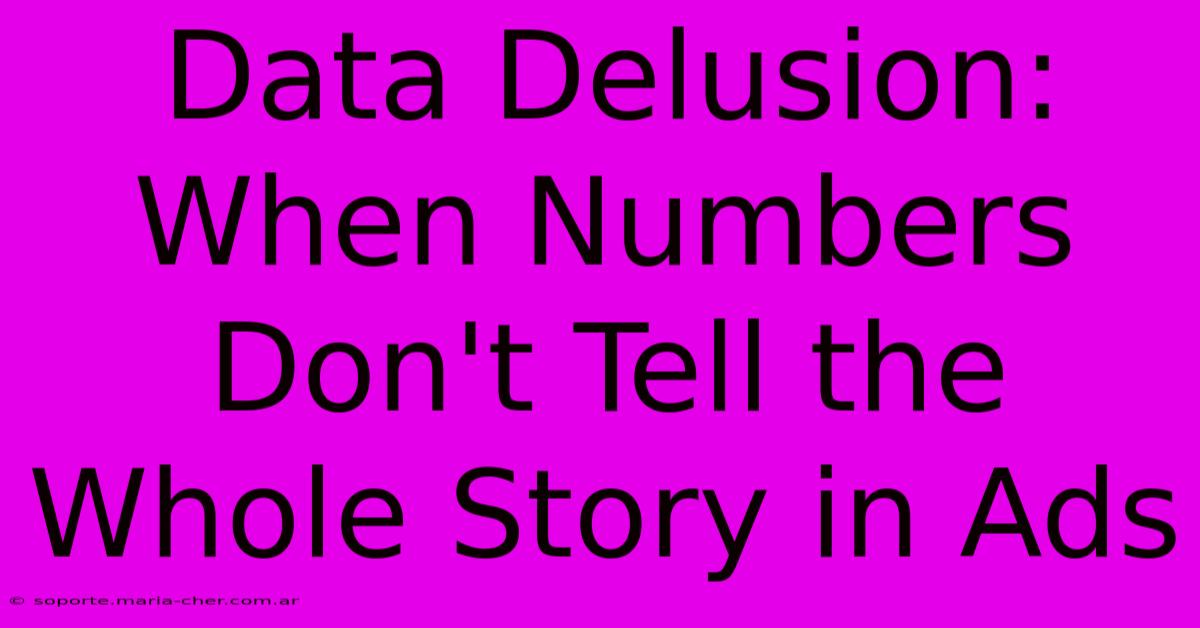Data Delusion: When Numbers Don't Tell The Whole Story In Ads

Table of Contents
Data Delusion: When Numbers Don't Tell the Whole Story in Ads
In the world of advertising, data reigns supreme. We're bombarded with metrics, KPIs, and analytics, all promising to unlock the secrets to successful campaigns. But what happens when we become overly reliant on these numbers, losing sight of the bigger picture? This is the realm of data delusion, where seemingly impressive statistics can mask a deeper, more nuanced reality. This article delves into the pitfalls of relying solely on numbers in advertising and explores how to interpret data effectively to avoid misleading conclusions.
The Allure of Numbers: Why We Fall for Data Delusion
The allure of data is undeniable. Numbers appear objective, quantifiable, and undeniably persuasive. A high click-through rate (CTR) screams success, while a low conversion rate signals failure. However, these numbers often tell only a part of the story. They can be easily manipulated or misinterpreted, leading to flawed strategies and wasted resources. Here are some key reasons why we fall prey to data delusion:
1. Ignoring Context: The Missing Pieces of the Puzzle
A high CTR is fantastic, but without understanding why it's high, it's meaningless. Was it driven by misleading ad copy, a highly targeted but small audience, or genuine interest? Similarly, a low conversion rate might be due to a faulty landing page, high prices, or simply a long sales cycle, rather than a problem with the ad itself. Context is crucial – without it, numbers are just numbers.
2. Focusing on Vanity Metrics: The Illusion of Progress
Vanity metrics are those that feel good but don't necessarily translate into business results. Impressions, likes, and shares might boost your ego, but if they aren't driving conversions or revenue, they're ultimately worthless. Prioritize key performance indicators (KPIs) that directly align with your advertising objectives, such as ROI, customer acquisition cost (CAC), and lifetime value (LTV).
3. Data Silos: A Fragmented View of Reality
Often, advertising data resides in silos – separate platforms and tools that don't communicate effectively. This fragmented view makes it difficult to see the complete picture. By integrating your data sources and analyzing them holistically, you gain a far richer understanding of your campaigns and their impact.
4. Ignoring Qualitative Data: The Human Element
Data analytics primarily focuses on quantitative data, but qualitative data is equally important. Customer feedback, surveys, and focus groups provide valuable insights into customer motivations, preferences, and pain points, which numerical data alone cannot capture.
Escaping Data Delusion: Strategies for Effective Data Interpretation
To avoid the trap of data delusion, adopt a more holistic and nuanced approach to data interpretation. Here's how:
1. Ask the "Why" Question: Understanding the Underlying Drivers
Always question the numbers. Don't just accept them at face value. Dig deeper to understand the underlying reasons behind the results. Analyze trends, segment your audience, and run A/B tests to identify the factors that truly drive success.
2. Focus on Actionable Insights: Turning Data into Decisions
Data is useless unless it leads to actionable insights. Use your data to inform your strategy, optimize your campaigns, and make data-driven decisions. Focus on the insights that will directly impact your bottom line.
3. Combine Quantitative and Qualitative Data: A Complete Picture
Don't rely solely on numbers. Combine quantitative data with qualitative feedback to gain a more comprehensive understanding of your audience and their behavior. This synergistic approach leads to more effective and impactful advertising strategies.
4. Regularly Review and Adapt: Staying Agile in a Dynamic Market
The advertising landscape is constantly evolving. Regularly review your data, analyze trends, and adapt your strategies accordingly. Stay flexible and agile to stay ahead of the curve.
Conclusion: Data is a Tool, Not a Prophet
Data is a powerful tool in advertising, but it's not a magic bullet. By understanding its limitations, asking critical questions, and integrating it with other forms of insight, you can avoid data delusion and use data to inform your advertising strategies effectively. Remember: numbers tell a story, but the whole story often requires a more human and nuanced understanding.

Thank you for visiting our website wich cover about Data Delusion: When Numbers Don't Tell The Whole Story In Ads. We hope the information provided has been useful to you. Feel free to contact us if you have any questions or need further assistance. See you next time and dont miss to bookmark.
Featured Posts
-
The Art Of Eveningwear Explore The Timeless Designs Of St John Evening Dresses
Feb 08, 2025
-
Frozen In Time The Timeless Appeal Of A Cool Summer Palette
Feb 08, 2025
-
Unleash The Power Of Flyers The Secret Spots That Will Skyrocket Your Reach
Feb 08, 2025
-
Desbloquea El Poder Del Lienzo De Propuesta De Valor La Estrategia Definitiva Para El Exito Empresarial
Feb 08, 2025
-
Unveiling The Hidden Treasures Lost Masterpieces From A Black And White Legend
Feb 08, 2025
